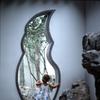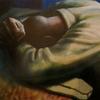HIGH HOSTS FIRST EVER COLLECTORS’ EVENING TO HELP BUILD THE MUSEUM’S PERMANENT COLLECTION
- ATLANTA, Georgia
- /
- January 07, 2010
New Acquisition to be Chosen Among Seven Proposed Works from Each of the High’s Curatorial Departments.
The High Museum of Art will host its first ever Collectors’ Evening on Saturday, January 30. The event, created to build and improve the Museum’s permanent collection, invites guests to take an active role in choosing the next work of art to join the collection. During the evening, each of the High’s seven curators will present a work of art as a potential new acquisition for their collection. Guests will then cast their votes and the High will purchase the work of art that receives the most votes. The event is open to the general public; tickets and more information including curator videos are available online at www.High.org/CollectorsEvening. To view the objects and related videos click on “Browse Proposed Acquisitions and Curator Videos.”
“The Collectors’ Evening provides an exclusive opportunity to help the Museum build its permanent collection while having fun and meeting other collectors,” said David Brenneman, Director of Collections and Exhibitions and Frances B. Bunzl Family Curator of European Art. “Attendees will participate in the Museum’s acquisitions process by voting on which works the High will purchase for its permanent collection. We’re very excited about this new event and look forward to finding out which works will be chosen.”
African Art
The proposed work from the African art department is “Nadi” (ca. 1850–1925), a commemorative stone sculpture measuring 21½ inches high. It comes from the region of the great Kingdom of the Kongo, founded along the coast of central Africa in the 14th century. The sculpture’s asymmetrical posture, with its legs crossed and its palm on its cheek, is iconic. In Kongo culture, the gesture of the hand to the cheek is associated with reflection and discretion or, moreover, deep sadness and desolation. All of the ateliers that produced sculptures in steatite (soapstone) like this one, called “mintadi,” disappeared by the mid-20th century. The acquisition of this work will help build strength in Kongo art for the High’s collection of African art. Approximately 40% of all peoples of African ancestry in the Americas come from Kongo and Kongo-influenced regions of central Africa.
American Art
William Mason Brown’s “Red Raspberries” (ca. 1866) is the proposed acquisition for the American art collection. The oil painting, measuring 6½ x 7½ inches, shows Brown at his best as a painter of traditional still-life subjects within a naturalistic setting. A disciple of the British art critic and theorist John Ruskin, Brown pursued subjects such as fruits and flowers, with raspberries being one of his specialties. Due to their blood-red color and highly perishable constitution when exposed to natural forces and time, raspberries served as a visual metaphor for the fragility of life. As the first example of a still life made in the popular Ruskinian style to enter the High’s collection, “Red Raspberries” will provide an important context for the Museum’s holdings of period still lifes by such artists as Decker, Hardy, Harnett, Oakey, Chase and a later work by Brown.
Decorative Arts and Design
The proposed work from the decorative arts and design department is a round-back chair and table from the “Sketch Furniture” series (2005) from Stockholm’s Front Design. The four members of Front Design—Anna Lindgren, Katja Pettersson, Sofia Lagerkvist and Charlotte von der Lancken—are internationally recognized for their innovations in furniture, ceramics, glass, lighting, textiles and interiors. Their “Sketch Furniture” series was introduced at Design.05 Miami in 2005, and was subsequently exhibited at Design Museum, London; Tokyo Wonder Site, Japan; The Museum of Modern Art, New York; and Cooper-Hewitt National Design Museum, New York. The unusual, lively furniture forms capture the dynamic quality of freehand drawings by using computer-aided design technology. A three-minute video clip of the design process will accompany the display of the work. Front Design has been awarded “Designer of the Future” at Design Miami/Basel, Switzerland, in 2007 and “Designer of the Year” at IMM Cologne, Germany, in 2010. The addition of this work will significantly enhance the High’s growing collection of contemporary design.
European Art
Thomas Rowlandson’s pen-and-ink “The City Chop House” (1775) is the proposed acquisition for the High’s European art collection. Rowlandson is known for being a brilliant draughtsman and perhaps the greatest caricature artist of his time. He began showing his work at the annual exhibition of the Royal Academy in 1775, the year that this drawing was made. He carefully studied the drawing style of his mentor John Hamilton Mortimer, but his fluid, expressive handling of the pen and the manner in which he applied different shades of ink washes to build his compositions are unique to Rowlandson. This depiction of a raucous meal at a “chop house,” probably in London, also shows Rowlandson’s unparalleled ability to poke fun at his contemporaries. The comically grotesque faces of some the figures derive from the artist’s study of Leonardo da Vinci’s drawings of ugly men and women. Although this work is from very early in Rowlandson’s career, it possesses all of the qualities that made him great. If acquired, this would be the first work by Rowlandson to enter the High’s permanent collection and would significantly strengthen the existing collection of more than 50 British drawings and watercolors by such artists as Thomas Gainsborough, George Romney and John Flaxman.
Folk Art
Cuban-American Felipe Jesus Consalvos’s mixed-media collage “Fictional Aspects of a Fact” (ca. 1920–1950) is the proposed acquisition for the folk art collection. Using readymade materials, Consalvos, a Cuban-American cigar roller, combined familiar images from pop culture to create witty, sophisticated compositions that make fun of politics and cultural sacred cows like marriage and death. Playing with image and text while employing visual puns and double entendres, he produced beautiful objects that are brilliantly colored, conceived and composed. This spectacular large-scale collage demonstrates how Consalvos propelled the early-20th-century homemaker’s craft of cigar band collages into the territory of such modernists as Max Ernst, Hannah Höch and John Heartfield. Political symbols, advertising images and old family photographs are woven together to create an intricate netting dominated by the image of a smiling, blue-eyed skeleton. Text clippings comment on nearby icons, adding another layer of meaning and reconfiguring relationships between images. Acquiring this work would boost the High’s holdings of folk art by Latino artists and join the many artists in the High’s folk art collection, which includes works by William Hawkins, Howard Finster and Charles Dellschau, among others.
Modern and Contemporary Art
The proposed work from the modern and contemporary art department is Kehinde Wiley’s painting “Thiogo Gliveira do Rosario Rozendo” (2009), which measures 48 x 36 inches. The Los Angeles native and New York-based artist is known for his reinterpretation of classical portraits featuring young African-American men. Wiley’s vibrant, larger-than-life paintings depict his subjects as contemporary heroes and warriors, blending the visual rhetoric of traditional portrait paintings with Western urban aesthetics. Wiley’s models wear their everyday clothing—typically, hip hop-inspired oversized jeans, t-shirts and jewelry—and assume poses taken from paintings and sculptures representative of the history of their surroundings. “Thiogo Gliveira do Rosario Rozendo” is part of the most recent series of paintings created in Rio de Janeiro, in which young men from the favelas (slums) pose as figures from public sculptures found throughout the city. Focusing on the historical depiction of Afro-Brazilians (who are descendants of African slaves), Wiley brings to light the continued economic challenges and social marginalization of a race that comprises the majority of the city’s labor force. Wiley’s work is included in the collections of the Metropolitan Museum of Art, the Walker Art Center, UCLA Hammer Museum and many other important public collections. “Thiogo Gliveira do Rosario Rozendo” would be the first work by Wiley to enter the High’s collection.
Photography
The photography department has proposed an acquisition of twenty photographs by photographer Paul Fusco from The Robert F. Kennedy Funeral Train (1968). On June 8, 1968, Robert Kennedy’s body was transported by train to Washington, D.C., for burial at Arlington Cemetery. On board the train was Paul Fusco, a photojournalist on assignment for LOOK Magazine. As the train made its way down the Eastern Seaboard, thousands of mourners came out to line the railway tracks and pay their final respects. Fusco documented the mourners, taking approximately 2,000 pictures during the eight-hour train journey. Fusco’s photographs simultaneously tell individual stories while capturing the collective emotion of the American public. Unfortunately, Fusco’s photographs were never published by LOOK, and the magazine folded three years later. Fusco was able to retain 200 of the pictures, but the rest were donated to the Library of Congress along with LOOK’s photographic archives. The portfolio remained unpublished until 1998, when it was featured in GEORGE magazine to commemorate the 30th anniversary of Kennedy’s death. The images have since been published in two separate books and have been exhibited internationally. This portfolio of 20 cibachrome prints is part of a limited edition of 15 sets that have been made expressly for museums. It will be the first work by Paul Fusco to enter the High’s collection, where it will complement the Museum’s prominent archive of more than 300 photographs that document pivotal events of the civil rights era.
High Museum of Art
The High Museum of Art, founded in 1905 as the Atlanta Art Association, is the leading art museum in the southeastern United States. With more than 12,000 works of art in its permanent collection, the High Museum of Art has an extensive anthology of 19th- and 20th-century American and decorative art; significant holdings of European paintings; a growing collection of African American art; and burgeoning collections of modern and contemporary art, photography and African art. The High is also dedicated to supporting and collecting works by Southern artists and is distinguished as the only major museum in North America to have a curatorial department specifically devoted to the field of folk and self-taught art. The High’s media arts department produces acclaimed annual film series and festivals of foreign, independent and classic cinema. In November 2005, the High opened three new buildings by architect Renzo Piano that more than doubled the Museum’s size, creating a vibrant “village for the arts” at the Woodruff Arts Center in Midtown Atlanta. For more information about the High, please visit www.High.org.
The Woodruff Arts Center
The Woodruff Arts Center is ranked among the top four arts centers in the nation. The Woodruff is unique in that it combines four visual and performing arts divisions on one campus as one not-for-profit organization. Opened in 1968, the Woodruff Arts Center is home to the Alliance Theatre, the Atlanta Symphony Orchestra, the High Museum of Art and Young Audiences. To learn more about the Woodruff Arts Center, please visit www.woodruffcenter.org.
# # #
Nicole Johnson
Public Relations Coordinator
High Museum of Art
1280 Peachtree St. N.E. | Atlanta, GA, 30309
tel 404.733.4585 | fax 404.733.4529
nicole.johnson@woodruffcenter.org
Follow the High on Facebook and Twitter at:
www.facebook.com/highmuseumofart
www.twitter.com/highmuseumofart
1280 Peachtree St.
Atlanta, Georgia
















